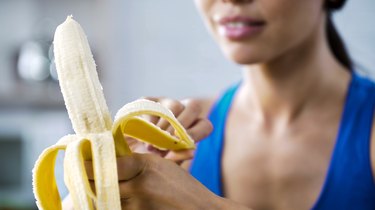
If you have prediabetes or type 2 diabetes, it's important to control your blood sugar levels via diet and exercise. While a healthy eating plan includes plenty of fresh fruits and vegetables, some "healthy" foods can raise blood sugar levels too much, making them a poor choice for people with diabetes.
Are bananas in that category? Here's what you need to know about eating bananas if blood sugar is a concern for you.
Video of the Day
Video of the Day
Read more: 7 Foods That Won't Cause Blood Sugar Spikes
The Carbs in Bananas
Glucose, aka blood sugar, is the body's main source of energy. The body gets most of its glucose by metabolizing the carbohydrates in food. One serving size of carbohydrates is 15 grams, and a large banana (one that's 8 to 9 inches long) contains 31 grams of carbs, or two servings. So yes, eating a banana will raise your blood sugar levels, because bananas contain carbs.
When it comes to carbohydrate metabolism, speed matters: The faster the body breaks down the carbs in any given food, the more rapidly blood sugar levels will rise. Simple carbs (such as those found in candies, sodas and fruit juice) are processed into glucose very quickly, meaning they affect blood sugar levels faster — and can cause blood sugar spikes in people with diabetes.
Bananas, like all fruits, are a source of simple carbs. But the fruit's ripeness also matters: Green bananas, specifically, contain more resistant starch, a type of fiber that can't be digested by the small intestine — and therefore can't raise blood glucose levels, according to Johns Hopkins University. This means that eating a green banana won't cause as severe of a blood sugar spike as eating a comparable amount of candy or other simple carbs that don't contain resistant starch.
Bananas have other health benefits, too. They're a source of potassium, vitamin B12, magnesium and vitamin C, according to the Harvard T.H. Chan School of Public Health.
What About Bananas' Glycemic Index?
The way specific foods affect blood sugar is known as the glycemic index (GI). The GI measures a given food's expected effect on blood sugar levels compared to the effect of pure glucose, which has a GI of 100 (the maximum). Any food with a GI under 55 is considered to have a low effect on blood sugar, and therefore a better choice for people with diabetes or prediabetes.
Bananas have a GI of about 52, according to the University of California, San Francisco (UCSF). However, that number changes as a banana ripens: During the ripening process, starches break down and are converted into sugar, as described in a study published in the January 2018 issue of Plant Biotechnology Journal. Therefore, the riper a banana is, the more sugar it contains — and the more it will affect blood sugar levels. A fully ripe, large banana can have a GI of 60, meaning that it's no longer a low-glycemic food.
Given that the sugar content of bananas changes over time, it's helpful to understand the concept of glycemic load (GL), which indicates how much a given food affects blood sugar per serving. Bananas have a GL of 12.4, which is considered a medium impact, according to UCSF. Therefore, one large banana will affect your blood sugar levels more than foods that are considered to have a low effect (such as grapefruit).
While it can be helpful to know a food's glycemic index and glycemic load, knowing your own body is more important, Heidi Karner, RDN, a dietitian at Harvard's Joslin Diabetes Center, points out. "Every person's body responds to food a bit differently, " she says. "Some people may experience higher blood sugars [after eating] certain foods, including bananas."
For Karner, no foods — including bananas — are off-limits for people at risk for diabetes. But she strongly emphasizes eating as many whole foods as possible, including fresh fruits, because they provide more health benefits overall. However, the key is to keep serving sizes in check.
Bananas and Diabetes: The Bottom Line
Bananas can be a good choice for people with diabetes as long as you eat them in moderation and opt for less-ripe bananas. While bananas do have a medium glycemic index, they tend to raise blood sugar levels more than fruits such as apples, which have both a lower GI (38) and GL (6) than bananas do.
If you have prediabetes or type 2 diabetes, Karner recommends that you eat a small portion of banana — start with half of the fruit — and then test your blood sugar to see exactly how your body responds.
- USDA: "Bananas, Raw"
- Johns Hopkins University: "What is Resistant Starch?"
- UCSF: "Glycemic Index and Glycemic Load"
- Plant Biotechnology Journal: "A Comprehensive Investigation of Starch Degradation Process and Identification of a Transcriptional Activator MabHLH6 During Banana Fruit Ripening"
- Harvard T.H. Chan School of Public Health: "Bananas"